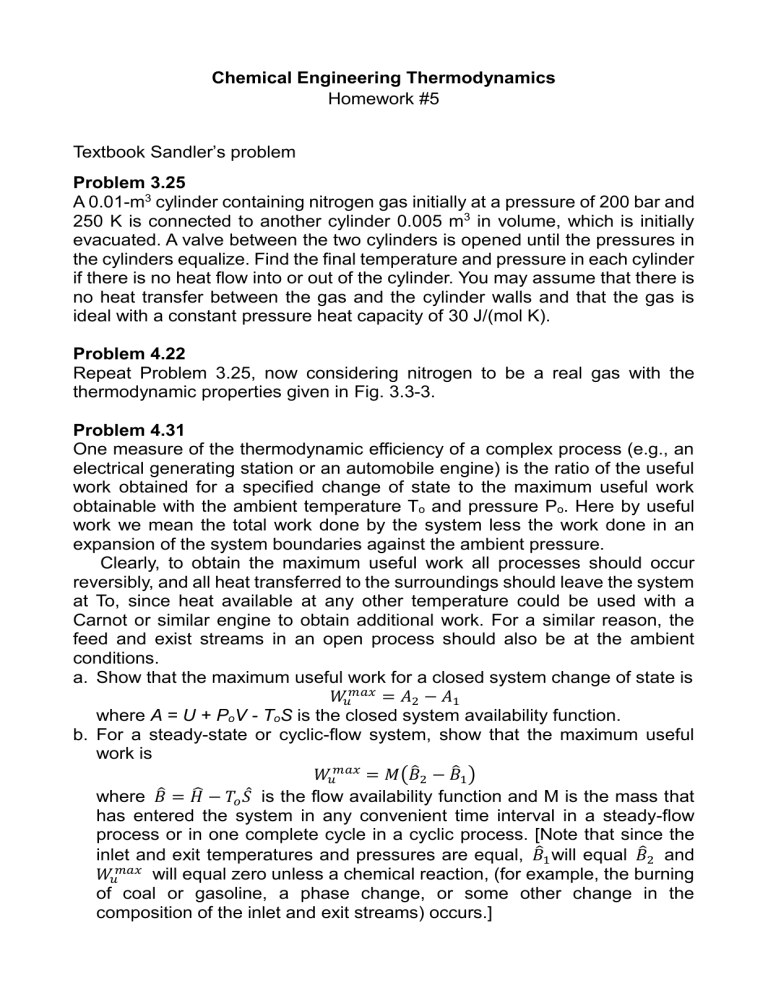
Chemical Engineering Thermodynamics Homework #5 Textbook Sandler’s problem Problem 3.25 A 0.01-m3 cylinder containing nitrogen gas initially at a pressure of 200 bar and 250 K is connected to another cylinder 0.005 m3 in volume, which is initially evacuated. A valve between the two cylinders is opened until the pressures in the cylinders equalize. Find the final temperature and pressure in each cylinder if there is no heat flow into or out of the cylinder. You may assume that there is no heat transfer between the gas and the cylinder walls and that the gas is ideal with a constant pressure heat capacity of 30 J/(mol K). Problem 4.22 Repeat Problem 3.25, now considering nitrogen to be a real gas with the thermodynamic properties given in Fig. 3.3-3. Problem 4.31 One measure of the thermodynamic efficiency of a complex process (e.g., an electrical generating station or an automobile engine) is the ratio of the useful work obtained for a specified change of state to the maximum useful work obtainable with the ambient temperature To and pressure Po. Here by useful work we mean the total work done by the system less the work done in an expansion of the system boundaries against the ambient pressure. Clearly, to obtain the maximum useful work all processes should occur reversibly, and all heat transferred to the surroundings should leave the system at To, since heat available at any other temperature could be used with a Carnot or similar engine to obtain additional work. For a similar reason, the feed and exist streams in an open process should also be at the ambient conditions. a. Show that the maximum useful work for a closed system change of state is 𝑊𝑢𝑚𝑎𝑥 = 𝐴2 − 𝐴1 where A = U + PoV - ToS is the closed system availability function. b. For a steady-state or cyclic-flow system, show that the maximum useful work is 𝑊𝑢𝑚𝑎𝑥 = 𝑀(𝐵̂2 − 𝐵̂1 ) ̂ − 𝑇𝑜 𝑆̂ is the flow availability function and M is the mass that where 𝐵̂ = 𝐻 has entered the system in any convenient time interval in a steady-flow process or in one complete cycle in a cyclic process. [Note that since the inlet and exit temperatures and pressures are equal, 𝐵̂1 will equal 𝐵̂2 and 𝑊𝑢𝑚𝑎𝑥 will equal zero unless a chemical reaction, (for example, the burning of coal or gasoline, a phase change, or some other change in the composition of the inlet and exit streams) occurs.] c. Compute the maximum useful work that can be obtained when 1 kg of steam undergoes a closed system change of state from 30 bar and 600 oC to 5 bar and 300 oC when the atmospheric conditions are 1.013 bar and 298.15 K. d. A coal-fired power generation station generates approximately 2.2 kWh of electricity for each kilogram of coal (composition given below) burned. Using the availability concept, compute the thermodynamic efficiency of the station. Problem 4.34 A device is being marketed to your company. The device takes in hot, highpressure water and generates work by converting it to two outlet streams: steam and low-pressure water. You are asked to evaluate the device to see if your firm should buy it. All you are told is that 10 kW of work is obtained under the following operating conditions: Mass flow rate (kg/s) T (oC) P (MPa) Steam Inlet 1.0 260 5.0 Liquid Outlet stream 1 100 Outlet stream 2 0.5 300 Quality unknown Saturated liquid a. What is the quality (mass fraction of vapor phase) of the steam in outlet stream 1? b. Is this device thermodynamically feasible? Problem 4.40 A sugar mill in Florida has been disposing of the bagasse (used sugar cane) by open-air burning. You, as a new chemical engineer, determine that by using the dried bagasse as boiler fuel in the mill, you can generate 5000 kg/hr of surplus steam at 20 bar and 600oC. You propose to your supervisor that the mill invest in a steam turbine–electrical generator assembly to generate electricity that can be sold to the local power company. a. If you purchase a new, state-of-the-art adiabatic and isentropic steam turbine, and the turbine exit pressure is 1 bar, what is the temperature of the exit steam, how much electrical energy (in kW) can be generated, and what fraction of the steam exiting the turbine is vapor? b. Instead, a much cheaper used turbine is purchased, which is adiabatic but not isentropic, that at the same exit pressure of 1 bar produces 90 percent of the work produced by the state-of-the-art turbine. What is the temperature of the exit steam, what fraction of the steam exiting the turbine is vapor, and what is the rate of entropy generation?


